Edouart, Augustin (McKechnie Section 1)
Edouart, the French-born profilist who passed much of his career in England, has received much attention from writers on the silhouette. The most important sources of information are two publications by Jackson: Catalogue of 5,200 Named and Dated Silhouette Portraits, by Augustin Edouart (London, 1911) and Ancestors in Silhouette; the latter contains the fullest account of Edouart's life and work. The artist's own now rare Treatise on Silhouette Likenesses (1835) should also be consulted, although allowances should be made for its egocentric tone. Some of the illustrations from his treatise have often been reproduced; I have included some of the less familiar examples among the illustrations in the present account.
Edouart was born in Dunkerque in 1789, the sixteenth child of his parents. He is reported as having managed a china factory, presumably in the neighbourhood of Dunkerque, at the age of nineteen. He served in the Napoleonic wars (in which four of his brothers died and he himself was decorated), though the exact period of his military service is unknown. In 1814 he married Emilie Laurence Vital, who bore him five children.
Previous writers agree that it was in 1814 that Edouart came to England, and the following notice, which appeared in the London press in December of that year, bears this out, while also throwing light on his early career in the country of his adoption:
Mr. A. Edouart has the honour to inform the Nobility that he is just arrived from France, with many designs in Hair, of a kind hitherto unknown, in which he is the sole Inventor. Fifteen years' study has enabled him to imitate the finest Engravings. His labors having never before been exposed to the public in any country, he begs to solicit amateurs of the Fine Art to honor him with a Visit in order that they may be able to form an idea of the beauty and delicacy of his performances.
He undertakes to make PORTRAITS, URNS, LANDSCAPES, COUNTRY HOUSES, SHIPS, TROPHIES, EMBLEMS, CYPHERS, &c., with the hair of the parties who may please to honor him with their commands.
This advertisement implies that Edouart had been studying the making of pictures in hair since he was ten years old. He is said to have first tried his fortune in England by teaching French: a phase which did not last for very long.
Some of Edouart's early hair pictures have survived. One of these, a hair picture on ivory entitled A Revenue Cutter chasing a Smuggler, was signed on the back 'Augn. Edouart, Londres, December, 1814', in the artist's hand. As he tells us in his Treatise that some of his hair pictures took three years to complete, and that sometimes, to achieve an effect, he had to split a single hair, he presumably brought with him to England a number of pictures which he had started, or possibly completed, in France. (Later, as a profilist, he was to make a success out of work that could be completed in less than three minutes.)
Another source of income lay in models made of hair embedded in wax. Exhibits sent in by Edouart at this period to the Royal Academy include the following:
1815 No. 680 Portrait of a horse
Portrait of an old man
(Sent in from 46 Rathbone Place)
1816 No. 734 Portrait of dogs
No. 735 Portrait of Dog
(Sent in from 17 Wardour Street)
That some of these models survived at least as late as 1928 is evident from an article on hair portraiture by Edouart, written by Ritchan and published in the Connoisseur in November that year. In this article there are two illustrations of pictures of dogs by the artist, both dated 1818.
346, 347
One picture bore a small printed label on the back which read 'Artist in Hair Work: Executed portraits, landscapes, and all kinds of devices with such human hair as may be furnished by his employers Likewise portraits of horses, dogs, or other animals done in their own hair. Specimens of his art may be seen at his residence.' Edouart must have carried out work of this kind for a long time: I have seen a reference in a Bath Guide of 1825 in which he described himself as a 'modeller', working from an address in Quiet Street, Bath (apparently in about April of that year). Later, he gave exhibitions of his hair work; one of these, at 27 Westmoreland Street, Dublin, included forty-five pieces of hair work, including fifteen models of animals.
According to the Treatise, Edouart's wife died during the summer of 1825, after eleven years of marriage. At 'the latter end of 1825' (again, according to the Treatise), Edouart was sitting with some friends who showed him some likenesses taken by 'machine'. 'In a moderate passion', he took out his scissors, and cut a profile of the father of the family in whose company he was, from white paper which he rubbed over with the black from a pair of candle snuffers. This was the first silhouette to be cut by the man who was to become the most prolific of all silhouette artists. The event must have occurred in about September 1825, for I own a fully documented profile by Edouart dated 29 October 1825, and taken at 4 Colonnade, Cheltenham.
A map of Cheltenham dated 1817 shows Nos 3 and 4 the Colonnade, both of which addresses were occupied by Edouart at various times. Street directories inform us that they were part of a property owned by a Mr Harward and later by his son, and that they were let as lodging houses. The upper part of what is now known as the Promenade did not exist, but what was just above, and all that part which is now below County Court Road, was called the Colonnade and was the chief shopping centre of Cheltenham. It is evident that it was at 4 Colonnade that Edouart began his career as a profilist, and that he began it by 29 October 1825, and not in 1826, as has previously been assumed.
It is said that Edouart's hair work somewhat impaired his sight, which, however, was sufficiently good at this time to enable him to embark on a career of silhouette cutting. He cut duplicates of all his silhouettes, and kept these duplicates (named and dated) in folios as a complete record of his work. After spending fourteen years in England, Scotland and Ireland, Edouart travelled to the United States, where he worked for about ten years. In 1849, he sailed for France, where he intended to settle, in the ship Oneida, taking with him his large collection of duplicate portraits in folios. After a rough journey, the ship encountered fierce storms off the coast of Guernsey and was wrecked on the rocks of Vazon Bay. Although the crew and passengers were saved, the cargo of wool from Maryland was lost, as were many of Edouart's folios. Edouart himself, ill from shock and exposure, was cared for by a family named Lukis. Out of 100,000 portraits recorded, about 12,000 were saved from the wreck, and these were given to the Lukis family.
When Jackson's The History of Silhouettes was published in 1911, she placed an advertisement in the Connoisseur in which she invited collectors to send her specimens of silhouettes for examination. One correspondent who replied said that he owned a number of books containing a quantity of old portraits. It proved that he was the husband of a former Miss Lukis of Guernsey.
Jackson acquired nine of the volumes (which were in fact folios of duplicates of Edouart's silhouettes) and, in July 1913 acquired a tenth volume from a grand-daughter of the Lukis. In the 1930s she acquired one more folio (no. XI; referred to in her Dictionary) containing many genre cuttings, some set against fine water-colour backgrounds. Jackson eventually catalogued duplicates from the first nine folios and published the paperback catalogue of the first 5,200 items in 1911 (this is referred to at the beginning of this entry).
The name of each of the 5,200 sitters listed in the catalogue is given, together with a number and also the number of the relevant folio. The contents of nine Folios are listed in this catalogue; 673 more names from the tenth folio are listed in Jackson's Ancestors in Silhouette. Jackson also acquired six more folios (referred to in her Dictionary) which record 3,800 examples of Edouart's work done in the United States. I am indebted to Jackson's catalogue, and Ancestors in Silhouette, for the following information about Edouart's career and travels in England, Scotland and Ireland, based on Jackson's lists of the contents of the first ten of the catalogued folios. The towns and cities in Britain in which Edouart was based during the years 1825-39, according to the first nine folios, are listed below. (As full a list as evidence allows of towns and districts in Great Britain and Ireland visited by Edouart, or mentioned in the home address of his sitters, is given in the Appendix. He may have visited some of these places only for the day; others may be named in missing folios: hence many more places are named in this list than in the pages which follow here.)
Folio i Perth
Edinburgh
Cheltenham (only one sitter, a Scotsman, is named; this may be an error)
Folio ii Glasgow
Leamington
Belfast
Folio iii Edinburgh
Folio iv Cork
Fermoy
Youghal
Killarney (only a few sitters)
Folio v London
Leamington
Folio vi Gloucester
Liverpool
Cheltenham
Worcester
Folio vii Cheltenham
Folio viii Bath
Bristol (only a few sitters)
Folio ix Cheltenham
The arrangement of the contents of these folios is not systematic, either chronologically speaking or otherwise. This is apparent from a study of Folio x. catalogued in Ancestors in Silhouette. In this folio most of the names are from Edinburgh, and the profiles were taken throughout 1830 and during the early months of 1831. There are also, however, the following isolated entries:
Birmingham 6 April 1838
Cheltenham 16 August 1836 (two portraits)
Glasgow 26 and 27 January 1830
26 February 1830
15 and 30 March 1830
3, 6 8, 15, 29 and 31 July 1830
10 December 1830
Leamington 27 May 1837
18 September 1837
28 July 1837
31 August 1837
1 and 16 October 1837
16 November 1837
Liverpool 27 May 1837
4 and 28 June 1837
1 July 1837
Most of these dates tally with the dates of Edouart's visits to the towns listed above, as they are recorded in the first nine folios. As will be seen from the second list above, duplicates from three different years were included in Folio x, apart from the Scottish entries fin 1830-31. It would seem that the methodical Frenchman occasionally found a few duplicates which had inadvertently been omitted from an earlier folio, and put them in the first folio (the tenth) that came to hand. He must have done this some years later, perhaps when he was preparing his materials to take to the United States, for Folio x, which consists basically of material from 1830-31, also contains two examples from 1836. eleven from 1837 and one from 1838. On the reverse of each duplicate, Edouart's signature is nearly always followed by the name of the place in which the profile was taken and the date.
Should a previously unknown example be found, a clue to its identity may lie in the place in which the silhouette was taken. As Jackson tells us that only. about 12,000 duplicates from the original 100,000 silhouettes were saved, her list is, of course, far from complete. The record of Edouart's work and travels, based almost entirely on information from the folios. follows below.
1825
There is no record of this year in the folios, but from Edouart's authenticated bust-length silhouette of Phoebe Porter we know that he was at 4 Colonnade, Cheltenham, on 29 October 1825.
367
1826
This year is scantily represented in the folios. Fewer than forty names are included. all assignable to Bath or Cheltenham. Edouart's address in Bath was 'Mr. Price's, 14, Old Bond Street', and in Cheltenham probably at 4 Colonnade. Traceable dates are as follows:
Bath
20 February
11 September
8, 15 and 18 November
20 December (there is another silhouette,of Frances Ord, merely marked Dec.')
Cheltenham
April (two silhouettes of the Hitchins family, not dated)
30 March May (the Hon. Mr Rous, not dated)
July (the Earl and Countess of Harcourt, not dated; Colonel Kelso, not dated)
10, 18 and 29 August
19 September (also a silhouette of Lord William Paget, marked 'Sept.' only)
12, 17, 20, 27 and 29 October
15, 16 and 29 November
1, 11 and 23 December
One may conclude from the brevity of the lists for this year that many names were in the lost folios. Presumably Edouart spent this year moving between Bath and Cheltenham. It is difficult to account for the fact that he appears to have cut profiles in both Bath and Cheltenham on the same day (for instance, on 15 November).
As some of the names are not followed by the day of the month, it is possible that Edouart did not become fully systematic in his method of documenting duplicates until late in 1826, and that when he began to organize it, he found that he had not marked on the back of some of his duplicates where he had taken the profiles.
1827
This year is well documented in the folios. Bath, Bristol and Cheltenham were the centres concerned. Again, some profiles were apparently taken in Bath and Cheltenham on the same day.
Bath 12, 13, 19, 20, 23, 27, 30 and 31 January
6, 7, 9, 12,16, 17, 21 and 26 February
2, 5, 14, 15, 16, 17, 20, 23, 26 and 31 March
1, 2, 7, 9, 12, 16, 17, 19, 21, 23, 24 and 30 April
1, 2 and 8 May
23 August (Silhouettes of General Paterson of Cheltenham and Miss Paterson of Bath were apparently taken on the same day.)
Bristol
Apart from one profile taken on 23 February (marked 'Bristol', but probably representing Mr Norton, of Bristol, and taken in Bath), Edouart appears to have
worked at 28 Park Street, Bristol, from about 25 May until 20 June. As the trade label which he was using at this time bears the deleted address of 4 Colonnade, Cheltenham, Edouart was apparently still using this address as his base in Cheltenham. The list for Bristol was apparently not complete in the extant folios, since I own a silhouette taken in this city, and dated 1827, which is not in the folio list. The sitter is the Reverend Joseph Wolf. Well known as a converter of Jews to Christianity, Wolf married Mary Drewe, whose silhouette by Jolliffe is illustrated in Section three.
1106
It will be seen from the list for Cheltenham, which follows, that the documentation in the folios for this year presents problems: a profile of a Mr Courtenay is clearly marked in the folios as having been taken on 9 June, whereas, according to other entries, the artist was apparently in Bristol on that day.
Cheltenham
7, 24, 26 and 27 January
6, 15 and 22 February
9, 10 and 28 March
11 and 17 April
19 May (This suggests a brief return visit to Cheltenham before beginning work in Bristol. Perhaps Edouart's children were left in Cheltenham while he was on his travels.)
June (several dates, almost all after 20 June, when Edouart probably came back from Bristol, but one or two dates earlier in the month are difficult to explain.) July (apparently spent entirely in Cheltenham)
August (again, apparently spent entirely in Cheltenham)
September and October (apparently spent entirely in Cheltenham)
2 November (the only date in November entered; possibly a folio is missing.)
21 and 23 December
1828
In all ten folios there are only two entries for this year:
16 May (Cambridge)
22 November (two portraits ⎯ curiously, of the same sitter ⎯ one in Manchester, the other in Leamington)
The Cambridge address used by Edouart during this year was 'At Mrs Bay's, Cambridge'.
1829
This year is well represented in the folios, but it seems that another folio containing London entries may have been lost, as not very many names from the capital city are included in those that survive. Edouart appears to have spent the early part of the year in London, where one address that he used was 111 Regent Circus (given on a silhouette, date 1829, in the Holborne of Menstrie Museum, Bath). Another address at which Edouart worked was at 'Mr John McRae, 155 Cheapside, London, Agent to Mons. E ' This address is given on Edouart's trade labels Nos 7 and 8, both of which mention the Duke of Gloucester's patronage. But it was not until later in 1829. when Edouart moved to Cheltenham, that he took a silhouette of the Duke (dated 29 July). Since he left Cheltenham for Scotland, and spent the years 1830-35 in that country and in Ireland, these labels cannot have been used before c. 1836.
In Cheltenham Edouart worked at 3 (not 4) Colonnade; this is the address given on trade labels on silhouettes taken in that town during 1829.
It should be noted that on Christmas Day 1829 Edouart took a profile of Gilbert Bethune in Edinburgh. It is certain, therefore, that he arrived in Scotland at the end of 1829, and not, as has previously been assumed, in 1830. This is confirmed by the entry for 30 December 1829 of a profile of 'Wm. Stuart, 81, George Street, Attorney, Exchequer', taken in Edinburgh. The last recorded profile taken in Cheltenham was dated 17 December. No doubt, Edouart's preparations for his journey to Scotland, and the journey itself, occupied the seven days between the two dates.
London
5 - 24 January inclusive
4 - 29 February inclusive
1 - 30 March inclusive
2 - 29 April inclusive
1 - 30 May inclusive
1 - 8 June inclusive
There is one more name in the folios for London for this year; a profile, dated 6 December, which Edouart may have taken on a visit to the capital to arrange for the move to Scotland.
Cheltenham
June (There is some doubt about the entries for the early part of the month, for Edouart appears not only to have taken profiles in Cheltenham on 2 and 6 June, but to have taken others in London on 4, 7 and 8 June. After the 9th, however, he appears to have remained in Cheltenham.
July (an entry for almost every day of the month) August and September (an entry for every day of each month)
October (an entry for almost every day of the month)
1-28 November
17 December
Edinburgh
25 and 30 December (Edouart appears to have celebrated Christmas by cutting the first of his profiles to be taken outside the borders of England at 72 Princes Street, his first base in Edinburgh. It is interesting to note that, according to one directory reference, this house was jointly owned by Cameron and Nicholson, Tailors, and by George Marshall Mather, Miniature Painter (also a silhouette artist; see Section Two).
Bath
There is one entry, for 18th January, for a profile of a Mr Dallas. It is probably an error the year was probably 1827.
1830
Much of Edouart's finest work dates from his years in Scotland and a number of names are recorded in the folios for his first full year there. Since, however, even more names are included for 1831, it is possible that a folio for 1830 is missing. Nevertheless, Edouart spent the entire year (successfully, it appears) in Edinburgh. Advertisements by him, published in Edinburgh, give us some further information. One appeared in the Scotsman in February; another in the Edinburgh Courant (29 April) announced that the artist would be settled at 72 Princes Street for several years. This statement was contradicted in the same paper on 5 June, in which Edouart announced his move to 99 Princes Street. More press notices (from both Scottish and Irish newspapers) are quoted below in the discussion of Edouart's Treatise. One of these shows that in May 1830 the artist threatened to leave Edinburgh, but apparently relented.
One Alexander MacNab, lithographer (his profile was taken on 17 May; Folio iii, No. 387) may have been responsible for some of the backgrounds used by Edouart for his work in Edinburgh. William Murray, whose profile was to be cut on 17 August 1831, was said to have been Edouart's draughtsman in the city.
1831
The year 1831 is well represented in the folios, which may be complete. Edouart was still in Edinburgh (presumably at 99 Princes Street) in January, for in this month the exiled King Charles X of France, with his family and entourage, first sat to Edouart. (A full list of these sitters, with dates of the portraits, most of which were taken in 1831, is given in Jackson's Ancestors in Silhouette, and is quoted in Appendix I.) Later in the year Edouart spent some time intermittently in Perth, where he first took a silhouette (of a Miss K. Innes) on 16 June, and took further silhouettes in September and October. Meanwhile, however, he returned in July to Edinburgh, where he took more portraits of the French royal entourage.
In November Edouart moved to 149 Queen Street, Glasgow, for there is a record of a profile taken there. I have found the record of a profile of a Miss Jane Galbraith (10 November; Folio ii, No. 129), and Edouart published advertisements in the Glasgow Herald and Glasgow Free Press in December.
1832
Some folios for this year are missing, as I discovered when, some years ago, I was asked to trace a family group (which showed five daughters, was dated 1832 and was taken in Glasgow) but could find no record of it in the folios.
A study of the list of names in the extant folios reveals that Edouart continued working in Glasgow until 15 October. Five profiles bear this date; they are of William Sage, his children John and Mary Anne, Robert White, and William White. On 10 October Edouart had taken a profile of a Mrs White (probably the wife of one of the two sitters just mentioned); her address is given as 140 Queen Street. Also an advertisement is recorded in the Glasgow Free Press for October 1832. It is clear from Edouart's Treatise that he visited Edinburgh in September and October. On 21 and 22 September he took three portraits there, one being of a M. Victor Gouverneur, from Paris, and in October he took, among others, a profile of Paganini (not recorded in the folios, which, as I have pointed out, are incomplete for this year). He also took profiles of members of Charles X's suite. Another profile is recorded at Peebles (21 August). Jackson (Ancestors in Silhouette) tells us that Edouart stayed in Scotland until the end of the year, by when he had taken 45,000 silhouettes.
1833
This year is completely missing from the folios. There must, however, have been several folios for this year, for Jackson tells us (Ancestors in Silhouette) that by July Edouart was established in Westmoreland Street, Dublin, where he took a further 6,000 silhouettes. Advertisements are recorded for the Evening Mail (Dublin, 24 July) and for the Dublin Evening Post (December). Edouart probably wrote part of his Treatise during this year.
1834
This year is represented in the folios, though only sparsely; not more than about twenty names are listed. Edouart remained in Ireland, and the folios indicate that he worked in three towns. There is one reference to Cork, where he stayed at 77 Patrick Street and took a profile on 22 July. Press notices, quoted in the Treatise, however, dated August and December, were published in Cork.
Scattered references in the folios show that the artist was in Killarney for most or all of September, on 1, 2 and 3 October and on 14 November. For most or all of December Edouart seems to have worked in Kinsale, where he took a portrait on Christmas Day.
1835
The folios for this year are also incomplete. Folio iv is devoted to the duplicates of Irish sitters. Jackson tells us (Dictionary) that Edouart took 151 silhouettes at Fermoy, 197 at Bandon, 112 at Youghal, and others at Limerick and Mallow.
Names entered in the folios for 2, 5, 8 and 11 January show that Edouart was still in Kinsale at the beginning of the year. There is one entry for Cork: a profile taken on 3 February.
By 14 March Edouart was in Bandon, where he also took many profiles in April and on 1 May. There is an entry for 21 May for Limerick.
By 29 May Edouart had begun work in Fermoy, where he seems to have taken portraits consistently throughout June, and one portrait on 23 July. Meanwhile, according to the folios, he had taken three profiles on 20 July at Bandon, possibly on an isolated visit. Perhaps they were in fact taken in Fermoy, and Edouart later documented them wrongly. By 8 September, Edouart was in Youghal, where he appears to have remained throughout the whole of October.
The artist is said to have visited Mallow in 1835, but, if he did so, the records of his sitters must be in a missing folio. Perhaps he was in Mallow during August; since no names are included in the extant folios for this month, they may have been recorded in one of the missing folios.
1836
By this year Edouart had returned to England. The first six months of 1836 are however, unaccounted for in the folios. It seems likely that Edouart spent some of this period in London (see the remarks about trade labels Nos 7 and 8 under '1829', above). We know from the trade label on an illustrated example that Edouart was in Oxford during 1836, possibly during this undocumented period.
380
No profile taken in Oxford, however, is listed in the extant folios. The earliest entry is for a profile taken on 2 July in Cheltenham. Edouart seems to have remained in this town until the middle of October; the last name listed for Cheltenham during this year is dated 14 October.
By 17 October Edouart was in Gloucester. He remained there at least until 12 December, when he took a profile of Mrs Samuel Ricketts. Soon after this he went back to Cheltenham, possibly to spend Christmas Day, but he appears to have been back in Gloucester on Boxing Day, when he took four portraits there of M. Philippe Pontean (or Ponteau) and his family.
1837
The entries in the folios for the early part of this year may be missing. Edouart probably spent some of this are very sparse, suggesting that perhaps two folios period in London (again see under '1829' above) and Coke mentions a silhouette, dated I 837, which shows Trade Label No. 7.
Edouart appears still to have been in Cheltenham on 5 January. By 26 January he had moved to Worcester, where he seems to have remained until 21 March. Perhaps he spent all February and March in this city. The paucity of names for these months, however, suggests that they were chiefly covered by a missing folio.
By 1 April the artist had arrived in Liverpool. Most of the dates in April and May record profiles taken in this city. Not many names are included for June, but as portraits were taken in Liverpool on 4 and 5 July Edouart probably remained in the city until about the middle of the month, when he made preparations to travel south to Leamington.
Many dates are recorded for Leamington, from 25 July until 26 December, and the folios for this town (ii and v) mat' be complete. On 22 December Edouart took the group profile of the Brockman family illustrated in Chapter Nine.
250
1838
This year is very sparsely represented in the folios, under thirty names being listed. Most of the folios for this year appear to be missing. Curiously, the few names which are listed are not given in the same folio. The entries are listed below.
Leamington
3 January (two silhouettes), 4 January (all in Folio v)
12 and 14 March (both in Folio v)
Birmingham
5 February (in Folio v)
I, 5, 8 and 9 March (all in Folio vi)
6 April (in Folio vi)
14, 19, 22 and 29 May (in Folios v and vi)
14 June (in Folio v)
Belfast
4 October (in Folio i)
2 November (in Folio i)
London
9 November (in Folio v)
The Belfast entries are hard to explain; they may be errors. Most of the extant entries for Belfast date from 1839 (they are listed in Folio ii).
1839
An examination of the folios reveals only one name for this year: a William Smith, apparently from Glasgow, whose profile was taken on 6 May
(Folio ii, No.309). Another silhouette (illustrated), taken in Belfast in April, is not listed in the extant folios.
384
Jackson tells us (Ancestors in Silhouette) that Edouart was established in New York by August.
While he was in Dublin in I 833, Edouart mounted a travelling exhibition of forty-five examples of his silhouettes (as well as an exhibition of his wax models and hair work, which had been mounted in Edinburgh in 1830 and had perhaps been shown even earlier). He may well have mounted the exhibition of silhouettes in large towns in Britain, and he certainly took it with him to the United States. According to the local press, the exhibition drew large crowds in Dublin. I give below the list of the subjects exhibited, abbreviated from Jackson's Dictionary. The descriptions and other details (between square brackets) were abbreviated by Jackson from Edouart's own wording; her versions have in some cases been further shortened by me. Nos. 21-26, 28-39, 41-43 are in Edouart's genre album ; Folio xi. This also contains farmyard subjects, and character studies which include Indian figures cut in the United States and mounted on sepia backgrounds.
1 Royal Exchange, London, where Rothschild and others are engaged in
business
2 Stock Exchange, London [with its members. Duplicates of these portraits are now in the library of the Stock Exchange and show many of the members in riding-kit as they rode to their offices from the outskirts of London.]
3 Monsieur Edouart's Rooms [in London, thronged with public characters.]
4 The Rev. Charles Simeon of Cambridge [preaching, in 9 different attitudes. His centenary having been recently celebrated, one of this series of portraits was acquired by the authorities for presentation at Cambridge.]
5 The late Rev. Edward Irving
6 Monsieur Edouart's Family in a garden
7 French Royal Family Charles X at Holyrood Palace The 4 October (in Folio i) with three other figures.
8 The Temptation with monsters, imps, London goblins and fairies]9 Four Scottish Chieftains
9 Four Scottish Chieftains
10 The Officers of the 90th Regiment Light Infantry [This picture, 4ft 8th. long, was exhibited at the Rochdale Free Library Exhibition in 1913.]
11 Royal Exchange, Glasgow [with eminent public characters]
12 The Presentation of the Sword of the Bey of Algiers to the Duke of Bourdeaux [as Henry V. taken at Holyrood Palace]
13 Eminent Actors, Musicians etc.
14 A View of Jesus College, Cambridge [a moonlight effect]
15 RoyalCrescent,Bath [with beggars, boys, sedan chairs, etc.]
16 High Street, Cheltenham [with well-known characters]
17 The Top of Park Street, Bristol [horsemen, a bull and crowd]
18 Mrs Hannah More at Barleywood Cottage [Bristol, 12 June 1827]
19 Sir Walter Scott in his Study at Abbotsford, 1831
20 Skirmish [a troop of hussars attacking a French outpost]
21 The Murderer
22 John's Funny Story, Treatise, Plate 10
23 The Good Match, Treatise, Plate 4
24 Jealousy
25 Mare The Night
26 Drunkenness and Derision
27 Plunderers The Juvenile
28 The Drunken Irishman
29 Past 12 o'clock
30 The Connoisseur
31 Devotion
32 Grandpapa's Surprise
33 The Hard Bargain
34 Magic Lantern
35 A Wale and Female Slave
36 The Haunted Chamber
37 The Mischievous Boy
38 How do you do? Treatise, Plate 13
39 The Long Story
40 The Chess Players
41 A Camp
42 A Rencontre
43 An Engagement
44 A Transparent Moonlight View
45 Monsieur Edouart and his two Sons in a Balcony
I have already referred (in Chapter One), and intermittently in this entry, to the manual on the subject of the silhouettist's art and technique which Edouart published in Cork in 1835. The full title is A Treatise on Silhouette Likenesses by Monsieur Edouart, Silhouettist to the French Royal Family and patronized by his Royal Highness the Duke of Gloucester and the Principal Nobility of England, Scotland and Ireland. Although it was this book which introduced the word 'silhouette' to the English language, in the course of it Edouart used the word 'likeness' far more frequently.
Though it is not easy to read the Treatise for pleasure, it contains much material which is of interest to students of the silhouette. Edouart discloses, for instance, that he sometimes cut full-length profiles which were based on existing bust-length pieces with satisfactory results. An unsurpassably brilliant freehand cutter, Edouart deprecates machine-cutting and — even more strongly — embellishing: two techniques which he would have scorned to use himself. He has much to say about this technique of cutting his sitters' limbs and hands:
The hand, by its motions, is very expressive; of all the parts of the body, the most active and the most rich in articulations: for this reason, I have taken care to produce a concordance between the gesture and the expression of the features; which is the most interesting and characteristic, in the attitude of a preacher, or an orator; and I may flatter myself with having attained, to a certain degree, that perfection in the Likenesses I have taken, representing these characters; which may be judged by the amateurs who will take the trouble to come and see them. The hand speaks, and its conformation, with more than twenty joints, produces the articulation of the language. A straight finger according to the angle of position, will indicate command, threats, derision — demonstration, attention, 8cc. &c. &c.
In fact the hands have such strong language, that, by carefully observing, one may have full proofs of it; they may be even used as telegraphs; which can be perceived, in the French, Italian, Spanish and other nations of the South, who speak almost as much by the hands as by the voice.
There is a chapter on the trials and misfortunes of artists (especially the low social standing of the 'black shade' men) and another on the importance of cataloguing and keeping duplicates (he mentions on page 80 that he had himself taken fifty thousand profiles). He reproduces at length the catalogues of his two Dublin exhibitions of his silhouette work, and of his 'mosaic hair work' and other hair work. The plates in Edouart's book illustrate some of his finest work. They are reproduced in this Section; Edouart's own comments on them, in cases where he gives them in the text of his Treatise in his highly idiosyncratic English, are incorporated in the captions.
The appendix to Edouart's Treatise consists of a collection of press notices, which convey a vivid impression of the artist's contemporary reputation in the towns where he practised. Some of these notices are quoted below.
It has been the boast of many of the disciples of Spurzheim. that his system had completely superseded that of Lavater, and truth to say, mankind have of late years evinced no slight degree of backsliding in this respect, since the more modern theory has taught them to look for the index no longer in 'the human face divine, but in the before unnoticed bumps and organs of the Cranium. Glad are we, however, to observe, that Physiognomy has once more begun to assert its pre-eminence over Phrenology, and that the Scissors of MONSIEUR EDOUART, are likely to Cut out the Callipers of SPURZHEIM. Lavater did much in illustrating his principles, by sketching those faces in which he found particular passions predominant; but all those sketches exhibit the features under the influence of the peculiar excitement, feeling, or passion, which it was his object to represent; but now, a novel character may truly be said to be given to his whole system, by the perfection to which MONSIEUR EDOUART, has attained in pourtraying the features with almost microscopic minuteness and with unerring fidelity, whilst he invests every trait of the Countenance with an expression in which the very mood of thought, the leading characteristics, if we may so say of the mind, the habit of social converse, and the influence either of gravity or of humour, of deep reflection or of sprightly fancy, of wisdom or of wit, are presented to the eye, with a grace and spirit which even the Painter's skill and the varied hues of the pencil, but rarely convey. So wonderful are his triumphs over the difficulties with which the Profilist has to contend, that no adequate idea can be formed of Monsieur Edouart's style, or of the merits of his Exhibition, without a personal inspection of his extensive Gallery, in which may be seen the portraits of all the most eminent men of the day, who have been gratified by the fidelity of the Artist, and pleased by the talents and unobtrusive humour of the man.
Cheltenham journal, June 1829
Among the more striking objects of interest or curiosity to which we occasionally direct public attention, we cannot help noticing the extraordinary production of MONSIEUR EDOUART'S rooms. The exhibition of this gentleman certainly affords the greatest treat we ever have met with for a long time. The specimens of his powers as an artist, exceed any thing of the kind we have ever seen. They are in fact, unique, both in point of style and execution; they almost go beyond description; and to be duly appreciated must be seen. In painting it is very common to complain of the absence of expression, even where every thing else is attained, that can constitute excellence in a picture. What then will be thought of him, who can transfer to a piece of common black paper, not only the utmost minutiae of form, manner, and costume, but even the speaking intellectual character of 'the human face divine'. Yet this, and more than this, does Mr. Edouart accomplish in his admirable Silhouette likenesses He is, unequivocally, a man of genius in his line. The profiles we have seen, go far to excel any thing we could have conceived practicable in that department of art. His specimens of Modelling in Hair, too, an invention entirely his own, are equally striking and beautiful. It is scarcely necessary to add, that a visit to Mons. Edouart's rooms will richly repay curiosity.
Glasgow Herald, December 1831
THE FINE ARTS. — In the simple, yet astonishing execution of profiles, Mons. Edouart has attained a high degree of perfection. This ingenious and self-taught artist has not recourse to any mechanical process, but with a painter's precision, though without the advantage of a painter's sketch, he with the utmost rapidity perfects a Silhouette, in which not only the countenance of the individual, but the prevailing tone of character, is preserved with the most discriminating accuracy. He has given ample proof of this in his likeness of Sir Walter Scott, the Dean of Faculty, and several other distinguished characters of this city. We regret to find, by his advertisement that M. Edouart is to leave Edinburgh in the course of a few days.
Edinburgh Evening Courant, 8 May 1830
MONSIEUR EDOUART. — As we anticipated, the rooms of that celebrated Silhouettist have been thronged with visiters [sic] since he announced his departure. During the last fortnight he has taken more than 600 likenesses, and now he is forced to decline taking new ones, till he has finished the numerous orders given him by the first families. His books of public characters, and duplicates of above 5000 likenesses taken in Edinburgh, having been exhibited at Holyrood Palace, where they were so much approved of by the Royal Family, that he had the honour to be received in the saloon last Friday evening, and took likenesses of all the members of the family and suite, with such accuracy of delineation, of expression and attitudes, that he received the most flattering compliments from his Majesty for his unrivalled talent. His exertions in the composition of groups having been uncommonly successful, that of the Royal Family of France, and those attached to the Court at Holyrood, cannot fail to excite deep interest. We hope that this high encouragement to the talent of Monsieur Edouart will be an inducement to him to postpone leaving us so soon as he had announced, and we earnestly recommend him to take an early opportunity to make, if possible, a new exhibition, which will afford him the means of showing the most part of his works of art, executed during his residence in our city.
Scotsman, Edinburgh. February 1831
MONSIEUR EDOUART. — It will be seen from our advertising columns. that this celebrated Silhouettist has taken Rooms at No. 77, Patrick-Street, for the purpose of showing his extensive collection of Likenesses, taken in various parts of England and Scotland. We visited the rooms yesterday, and have rarely been more highly gratified. There is to be seen the Likenesses of most of the celebrated characters in the Kingdom, taken in almost every possible attitude. The resemblances are striking and spirited, and the execution truly extraordinary. We trust he will meet with the same encouragement which he has received in Dublin, where he took more than 6000 Likenesses of the most eminent characters, amongst which are the Marquess of Anglesey, his Grace the Duke of Leinster, their Graces the Archbishops of Dublin and Tuam, the Bishops of Dromore, Raphoe, Ferns, &c. and the most distinguished in the Church, the Army, the Bar, and private life.
Cork Southern Reporter, August 1834
MONSIEUR EDOUART. — This celebrated. and we may say, unique genius in his Arc is doing wonders at the spirited town of Kinsale. The number of Likenesses he has already taken is surprising for so small a place; and what is more wonderful, is, the number taken from description. A person, who had the opportunity of seeing several of his extraordinary executions in Kinsale, says, that for the correctness of delineation of the living expressions and characteristic attitudes, they are as striking, as if the persons had sat for them, the effect produced upon the relations and friends when they beheld those resurrections, is affecting. As has been noticed several times before, Monsieur Edouart is an incomparable artist in his execution; his equal is not to be found; and as the inhabitants of Kinsale express it; his performances are taken as if by inspiration. Those that neglect the opportunity of having Likenesses from him, will be sorry for it. We understand that he has been engaged to visit Fermoy, Mallow, Limerick, and several other places.
Cork Evening Herald, December 1834
EDOUART'S LATER CAREER IN THE UNITED STATES
1839- 49
Although we are principally concerned here with Edouart's career in Britain and Ireland, I shall give below documentary details of the prolific ten years (1839-49) which he spent in the United States, and then very briefly summarise the available information about his last years in Guernsey and France. In Appendix I I give a full list of the places in the United States which Edouart visited, or in which (possibly in some cases) some of his sitters lived. The same qualification applies to the list, given below, of the places which Edouart apparently visited in each given year, which I have included for the benefit of those who own dated but unidentified examples of his work.
1839 Edouart's headquarters were at 114 Broadway, New York. He also probably visited:
Boston
Brooklyn
Philadelphia
Saratoga
1840 Edouart took 531 silhouettes. The places which he visited include:
Washington (April and May)
Saratoga (July and August)
Philadelphia (September)
Baltimore (September)
1841 Edouart took 765 silhouettes. He took more in Washington than in any other place; the other places which he visited include:
Alabama Maine
Baltimore Maryland
Buffalo Massachusetts
Charlestown Natchezo
Columbia North Carolina
Columbus Ohio
Connecticut Philadelphia
Georgetown Portland
Greenville Potomac
Illinois Providence
Indiana Troy
New Jersey Virginia
New London Wisconsin
1842 Edouart took 641 silhouettes. He visited:
Boston
New York
Philadelphia
1843 Edouart took about 700 silhouettes at, or on visits from:
Baltimore New Braintree
Boston New Orleans
Chambersburg Norwich (Connecticut)
Charlestown Perth
Detroit Philadelphia
Dover (Delaware) Pittsville
Germanstown Smyrna
Lewis Troy
Michigan Virginia
Natchezo Worcester (Massachusetts)
1844 Edouart took 589 silhouettes. He probably visited:
Boston
New York
Philadelphia
The folios which cover Edouart's work in the United States, formerly owned by Jackson, were virtually complete up to the end of 1844. The rest were missing, but a few entries, covering the later years of Edouart's tour of the United States, were apparently slipped into the earlier extant folios. The details are given below.
1845 Only eight silhouettes recorded, taken in New York and Saratoga (a spa centre, perhaps corresponding with Bath in England, which Edouart visited many times)
1846 Four silhouettes recorded, at Baltimore and New York
1847 One silhouette recorded, taken in Washington
1848 One silhouette recorded, taken in New York
1849 Two silhouettes recorded, taken in New York and Saratoga. (In New York, Edouart's address was at Messrs A. Bell and Son, 117 Fulton Street.)
During this tour of the United States Edouart took profiles of many prominent citizens (some of them illustrated). For those who are interested in these sitters, I recommend a study of Jackson's Ancestors in Silhouette. Jackson gives details of a long list of Edouart's American sitters. Some of these are listed below, with information added by me.
John Quincey Adams (1767-1848), sixth President of the United States, son of John Adams, who succeeded Washington in 1797. Taken in Washington, 10 March 1841.
Timothy Bigelow (1767-1821), Speaker of the House of Representatives in Massachusetts. Taken in Boston, 9 April 1842.
Charles Caldwell, M. D. (1772-1853), Professor of Natural History at the University of Pennsylvania in 1816. Taken in Louisville, 21 May 1841.
John E. Calhoun (1782-1850), Secretary of State in President Tyler's administration. Taken in Washington, 8 March 1841.
Henry Clay, famous orator. Taken 10 March 1841.
Shobal L. Vail Clevenger (1812-43), eminent sculptor who, in Boston, made busts of such famous people as Henry Clay and Daniel Webster.
Henry D. Gilpin (1801-1860), Attorney General of the United States in 1840. He edited James Madison's papers. Taken in Washington, February 1841.
William Henry Harrison (1773-1841), ninth President of the United States, from 4 March to 4 April 1841, when he died. He was succeeded without election by the Vice-President, John Tyler. Taken in Washington, 20 February 1841.
Philip Kearney (1815-62), American general who lost an arm in Mexico and was later killed at the Battle of Chantilly. Taken, while he was a lieutenant, on 18 May 1841.
Henry Wadsworth Longfellow (1807-1882), poet. Taken in Boston, 7 December 1841.
General Alexander Macomb (1782-1841), commander of the American force which defeated the British at Plattsburgh in 1814, and from 1828 until his death Commander-in-Chief of the American army. Taken in Washington, 19 February 1841.
W. L. Marcy (1786-1857), Secretary of War in 1839. Two silhouettes recorded in the folios. Taken 28 September 1839.
George McClellan, NI. D. (1796-1847), eminent surgeon who founded the Jefferson Medical College in Philadelphia. Taken in Philadelphia, 25 March 1843.
Franklin Pierce (1804-1869), fourteenth President of the United States. This silhouette is undated in the folios.
Joel Roberts Poinsett (1779-1851), Secretary of War in Van Buren's administration. Taken probably in Washington, 21 January 1841.
Josiah Quincey (1772-1864), President of Harvard College. Edouart took ten silhouettes of members of the Quincey family in Boston, 8 January 1842.
William Henry Seward (1801-1872), one of the founders of the Republican Party and Governor of New York. Taken in New York, 2 October 1839.
Henry Tuman (1801-1846), New York portrait-painter who visited England and there painted, among others, a portrait of Wordsworth. Taken in New York 1 October 1840.
John Tyler (1798-1862), tenth President of the United States. This profile, given to the United States by Mrs Jackson, was hung in the White House. Taken in Washington, 1841.
Martin Van Buren (1782-1862), eighth President of the United States. Taken in Washington, 1 January 1841.
Robert J. Walker (1801-1869), lawyer and writer on political economy. Taken in Madisonville, 25 March 1841.
Daniel Webster (1782-1852), Secretary of State in the administrations of both President Harrison and President Tyler, and an outstanding orator. Taken in Saratoga, 20 August 1840.
Hon. Robert C. Winthrop, M. C. (1809-1894), statesman and orator. Taken in Boston, 20 May 1840.
Henry A. Wise (1806-1876), for three years Governor of Virginia. Taken in Virginia, 12 February 1841.
Levi Woodbury (1789-1851), Secretary of the Treasury in President Jackson's administration and later (until 1841) in Van Buren's. Taken in Boston, 20 May 1840.
Also recorded is a group of bust-length silhouettes cut from earlier portraits. This group included a silhouette of Benjamin Franklin, taken from a portrait painted when Franklin was eighty-four.
In 1849 Edouart set out on his journey for England, which culminated in the shipwreck which I have already mentioned. After a period of rest and recuperation spent with the Lukis family in Guernsey, Edouart went on to Calais. In a letter sent to Thomas Lukis from Calais on 29 May 1850 Edouart says that he has somewhat recovered his health. He did not, however, return to his silhouette work, and remained in Calais. He died in 1861 at Quines, aged seventy-two.
EDOUARTIS WORK
Apart from the addition of a few lines indicating costume detail. evident on a few examples cut in the United States, Edouart confined himself to freehand cutting in plain black, of which he was a master. As he began executing this type of work in 1825. it is possible that his early silhouettes were cut from white paper which was afterwards blackened, but later he probably used the black papers which became available c. 1826.
Edouart created many genre pieces as well as bust-length and full-length profiles. Full-length profiles predominate in his output, his bust-length works being comparatively rare. His groups are particularly fine; some of the best of them are illustrated in his Treatise. He often set his groups, and less often his single figures, either against already lithographed backgrounds (many of which, from 1834. were executed by Unkles and Klason of Cork) or against painted backgrounds (frequently in pale umber and Chinese white). Some of the backgrounds on his Scottish examples may have been painted by 'William Murray, Mons. Edouart's draughtsman'.
Some of Edouart's very early full-length figures are as high as 11 in., but from c. 1827 he cut full-lengths of about 7½ in. (for a subject of average stature). We know from his Treatise that he took care to secure an accurate likeness, although he took a number of profiles (those of clerics in particular) from memory.
The termination of Edouart's bust-length profiles is best considered by an examination of the illustrated examples, since it is variable.
Edouart's work was all documented in the folios, each duplicate being inscribed on the back in the manner illustrated. He was scrupulous in signing his work; in some cases the signature has faded over the years, but it is always at least partly visible. I do not think that an unsigned silhouette could be attributed with certainty to Edouart.
401
Edouart never painted on glass. Some of his silhouettes, however, have been copied on glass and offered for sale as his work. Some of these examples date from this century; possibly some are still being produced. Some are framed in verre églomisé, but, if the gold on these examples is examined under magnification, it will be seen to be coarse and crazed, and lacking in the fine execution of early nineteenth-century work.
Edouart took with him on his travels a stock of maple frames for his full-length work; these were made with a special type of veneer, flat, not rounded, and edged on the outer sides with another narrow strip to give a neat finish.
Over the years, some examples have been reframed, not necessarily in the same type of frame as the original. Maple frames with rounded surfaces have sometimes been used in such cases it is doubtful whether Edouart used these himself. Some groups have survived in ebonized wood frames, turned or slightly decorated, which may be original. Sometimes the maple frames have been blackened over; paint-stripper should reveal the maple beneath. Some of Edouart's silhouettes remain unframed; a number of examples can be seen in the Victoria and Albert Museum, London.
TRADE LABELS AND SIGNATURES
Eight trade labels are known, and an example of each is illustrated. The labels were stuck to the back of signed silhouettes, and only rarely (since most of Edouart's work is signed) to the back of unsigned examples.
393-400
No. 1 was used in 1825 at 4 Colonnade, Cheltenham. No. 2 was used in 1826 at `Mr Price's, 14 Old Bond Street, Bath'. No. 3 was used in 1827 at 28 Park Street Bristol (the address at 4 Colonnade, Cheltenham, has been deleted). No. 4 was used in 1828 at Mrs. Bay's', Cambridge. No. 5 was used in 1827, and in 1829, June to December at 3 (not 4) Colonnade, Cheltenham. No. 6 was used in 1836 at the bottom of the High Street, Oxford. Trade labels 7 and 8 (neither of which I have seen on a signed and dated silhouette) both mention the patronage of the Duke of Gloucester and were probably used in 1836 (a year which is poorly represented in the folios) and 1837; see under '1829'.
Most of Edouart's silhouettes are signed on the front and the year is usually added. Edouart some times signed his work by hand, sometimes with a stencil.
402, 403
In rare cases, the initials 'A. E.' are stencilled on the back of the card bearing the silhouette.
Ills. 154, 211, 249, 250, 346-403, 637

Augustin Edouart’s children: Emilie Gaspard (aged two and a half) and Augustus Gaspard (aged six or seven).
Silhouette by Augustin Edouart, June 1828.
costume dating points
Emilie
The large-brimmed stiff-crowned hat, worn on the back of the head.
The dress, low-necked, full-sleeved, tied with a long sash, and of a length well below the calf.
The ankle-length drawers, in place of petticoats.
The shoes, with strings.
The parasol, shaped like a pagoda in conformity with adult fashion.
Augustus
The peaked cap, with tassel on the crown.
The wide, turn-down frilled collar.
The skeleton suit, soon to go out of fashion.
The shoes, with strings and slightly pointed toes.
From E. Nevill Jackson, ‘Ancestors in Silhouette’ (1921), by courtesy of Bodley Head
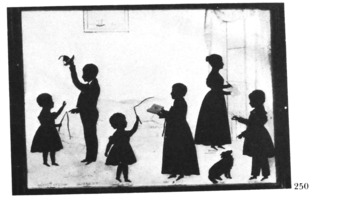
The children of Captain Brockman, of Leamington. From left to right: Julius (aged three and three-quarters), Arthur (aged twelve), Charles (aged two), Frederick (aged nine), Caroline (aged about thirteen or fourteen), Lewis (aged about eight).
Silhouette by Augustin Edouart (Folio V, No. 134), December 1837.
costume dating points
Julius and Charles
The short hair, not cut close at the back, as is Arthur’s.
The dress, with low neck and full short sleeves.
The boots (probably cloth).
Arthur
The short hair, cut close at the back.
The small turn-down collar, worn over an Eton suit.
The trousers, probably worn with shoes (since strings are shown) and strapped.
Frederick
The hair, cut much like that of his younger brothers.
The ‘Bluecoat’ uniform (of Christ’s Hospital School), which has not changed down to the present day.
The shoes with strings, like Arthur’s.
Caroline
The hair, drawn into a knot at the back of the head in the adult style of the time.
The low-necked, ankle-length dress, with sleeves showing the wide shoulder line of the late 1830s.
Lewis
The hair, similar rot het of Julius, Charles and Frederick.
The wide, turn-down frilled collar.
The Petersham coat.
The trousers, narrow at the ankle.
The shoes with strings, like Arthur’s.
Author’s collection
SECTION ONE

Model of ‘Tartar’, an Irish terrier, made in hair and wax by Augustin Edouart, 1818.
From Ritchan, ‘Hair Portraiture’, November 1928, by courtesy of the ‘Connoisseur’
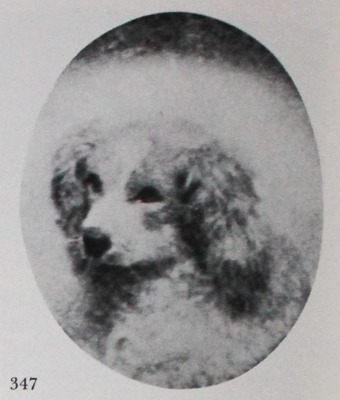
Model of a spaniel, made in hair and wax by Augustin Edouart, 1818.
From Ritchan, ‘Hair Portraiture’, November 1928, by courtesy of the ‘Connoisseur’
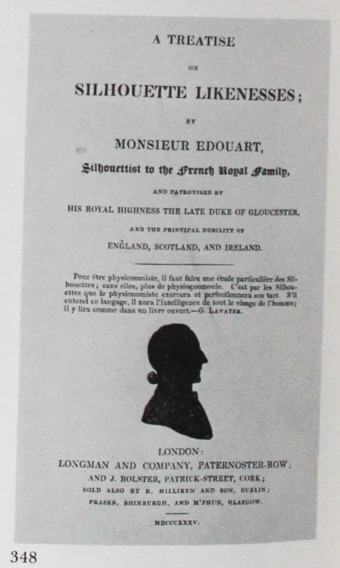
The title-page of Augustin Edouart’s Treatise, published in Cork in 1835.

Signed self-portrait by Augustin Edouart, showing the artist’s folios in the background.
Augustin Edouart, Treatise, etc. (Cork, 1835), frontispiece.

William Frederick, Duke of Gloucester (1776-1834), Augustin Edouart’s patron. Cut silhouette by Edouart, Cheltenham, 29 July 1829 (Folio vii, No. 177). The Duke was the son of George III’s younger brother, William Henry, Duke of Gloucester and Edinburgh, and Maria, Dowager Countess of Waldegrave (natural daughter of Sir Edward Walpole and Dorothy Hammond). In 1819 he married his first cousin, Mary, fourth daughter of George III. The Duke was slim, which gave rise to the nicknames of ‘Slice’ and ‘Cheese’ by which he was known in royal circles. Another of his nicknames was ‘Silly Billy’. Edouart was extremely proud of the Duke’s patronage, and a chapter in his Treatise, devoted to a list of his commissions, is headed by the Duke’s name, followed by the names of the exiled Charles X of France and his family. One of the originals of this silhouette is in the Victoria and Albert Museum, London (No. E.2427-1913); it is dated (apparently in the artist’s hand) 5 August 1829.
Augustin Edouart, Treatise, etc. (Cork, 1835), Plate 2.
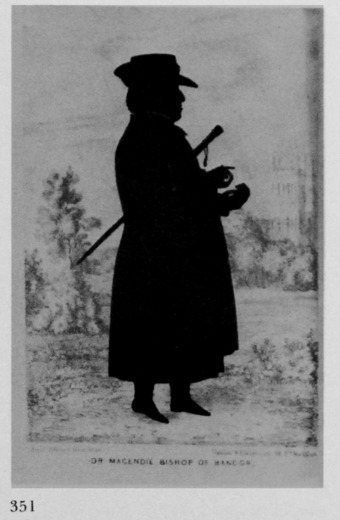
Dr Magendie, Bishop of Bangor.
Cut silhouette by Augustin Edouart, 1826.
This is an early example of Edouart’s work. The background, which precumably shows Bangor Cathedral, was probably drawn in pencil especially for this portrait.
Augustin Edouart, Treatise, etc. (Cork, 1835), Plate 3.
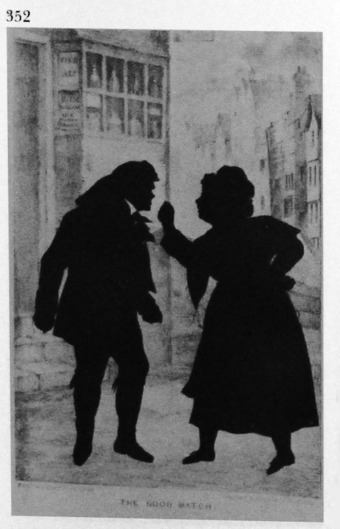
The Food Match.
Cut silhouette by Augustin Edouart (no. 23 in his exhibition). Edouart writes (Treatise), ‘Here the passion of quarrelling is expressed by the woman meeting her husband, a coal porter, at the door of the public-house, where she attacks him with a torrent of abuse. Her menacing attitude expresses her defiance, his expression shows that he is thwarted sic to the utmost degree of forbearance, and, by the attitude, he is about to stop her mouth.’
Augustin Edouart, Treatise, etc. (Cork, 1835), Plate 4.
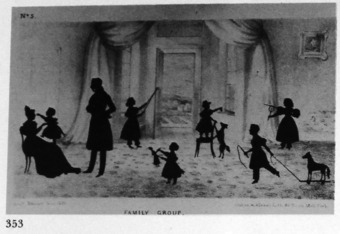
Silhouette of a family group by Augustin Edouart, possibly 1830.
Edouart writes (Treatise) that this piece ‘presents a drawing room, where a family of 8 individuals, are engaged in various amusements. The boy with the horse and his sister with the … doll form the first plan. The father, mother, and baby the second plan; the boy on the chair engaged with a dog, on the third plan; the sisters playing aux grâces on the fourth plan: the arrangement of this group gives extent to the room, and the figures being placed at a reasonable distance from each other, renders the effect of perspective, at one, elegant, and natural’.
Augustin Edouart, Treatise, etc. (Cork, 1835), Plate 5.

All in a Row!
Cut silhouette (undated) by Augustin Edouart. Below it are inscribed the words, ‘Copied from an Original’. Edouart writes (Treatise), ‘Let us compare (Plate 5) with No. 6, which is an exact copy of a family All in a Row! This chef-d’oeuvre of Art has been lent to me, by a person who admired it greatly, on account of the precision of each individuals’ height: measure, as it were, according to his age, and which seemed to be the only means of ascertaining the respective Likenesses.’
Augustin Edouart, Treatise, etc. (Cork, 1835), Plate 6.

Daniel O’Connell.
Cut silhouette by Augustin Edouart, 1835, taken in Ireland. Below the silhouette is O’Connell’s signature in facsimile. Edouart writes (treatise), ‘I had seen him only once, and it was in the Chamber of Commerce in Dublin, where he was reading the newspaper in which I here represent him. I looked at him for Five Minutes only… I returned home, and immediately made the Likeness.’
Augustin Edouart, Treatise, etc. (Cork, 1835), Plate 7.
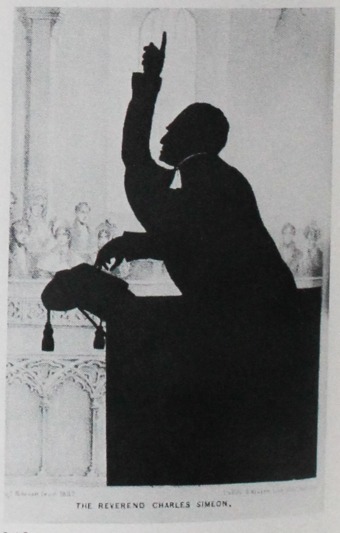
The Reverend Charles Simeon.
Cut silhouette by Augustin Edouart (No. 4 in his exhibition). Edouart writes (Treatise): ‘it was the same with a number of public characters, of whom I had no opportunity to have a sitting; principally of preachers, and by going to hear them at church, I took by remembrance likewise a great number, amongst which the Rev. Charles Simeon of Cambridge is represented, in nine different attitudes, one of which may be seen, Plate 8.’ Most of these nine silhouettes are backed with the trade label (No. 4) which Edouart used at Cambridge. See also 372.
Augustin Edouart, Treatise, etc. (Cork, 1835), Plate 8.
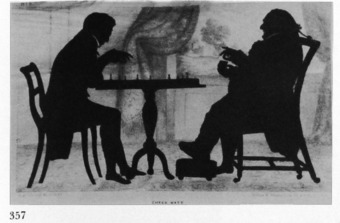
Check Mate.
Cut silhouette of chess players by Augustin Edouart.
This example has often been copied by modern artists, on glass, and sold as an original piece. Edouart was very proud of it and refers to it in his Treatise when attacking the art of embellishing: ‘Is it possible to give more expression to them, by giving gold hair to the old gentleman, a gilded coat, with white cravat and frill, a blue waistcoat as whimsical persons may wish? The fine sharp edge I give to the coat…’, and so on.
Augustin Edouart, Treatise, etc. (Cork, 1835), Plate 9.
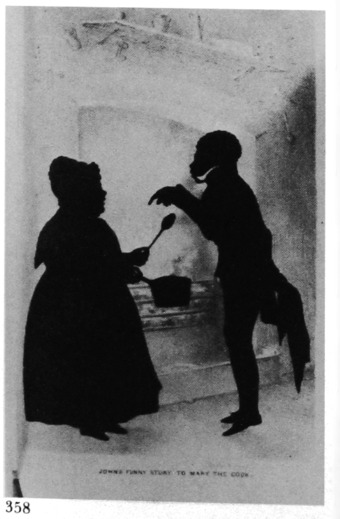
John’s Funny Story to Mary the Cook.
Cut silhouette by Augustin Edouart (No. 22 in his exhibition).
Edouart devotes a page of his Treatise to this piece; two excerpts follow: ‘…the uplifted spoon, and carelessly held saucer pan, are indications of the fascination she is held in…the complacent grin on her face is about to become a broad laugh.’ Turning to the black man John, who tells the story, he writes, ‘His comic seriousness at the same time foretells the burst of laughter he is about to enjoy, as the result of his funny narration…
Augustin Edouart, Treatise, etc. (Cork, 1835), Plate 10.
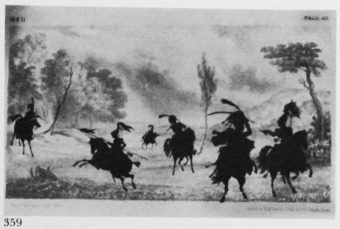
Skirmish of Cavalry.
Cut silhouette by Augustin Edouart. This piece, a brilliant example of cutting, is slightly different from Skirmish (No. 20 in Edouart’s exhibition).
Augustin Edouart, Treatise, etc. (Cork, 1835), Plate 11.
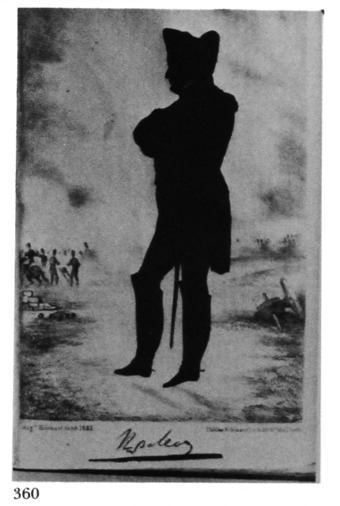
Napoleon Bonaparte.
Cut silhouette, with painted background, by Augustin Edouart. Below the silhouette is a facsimile of Napoleon’s signature. This brooding likeness of Napoleon s admirable, as is the painting of the background in the original, with its suggestion of fleeing soldiers in the distance.
Augustin Edouart, Treatise, etc. (Cork, 1835), Plate 12.
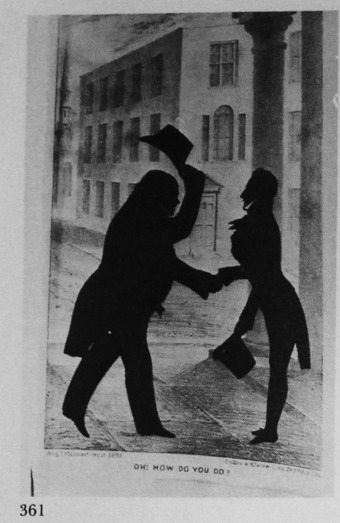
Oh! How do you do?
Cut silhouette by Augustin Edouart (no. 38 in his exhibition). Edouart writes (Treatise): ‘This is a familiar occurrence which everyone is acquainted with. The English gentleman accosts his Parisian friend with the utmost cordiality apparently after a long separation. The attitude at once declares the difference of nation, the Frenchman almost bent in two, is trying to extricate his hand from the warm grasp of his friend, and the expression of the faces shows the anxiety they are in, to know what has occurred since they last met.’
Augustin Edouart, Treatise, etc. (Cork, 1835), Plate 13.

John Smith Barry, Vice-Commodore of the Royal Cork Yacht Club.
Cut silhouette by Augustin Edouart, Cork, 1835. Edouart writes (Treatise): ‘I annex here the Likeness of a Gentleman well known for his liberal Patronage of the Arts. It is with his kind permission that I have represented him in a seafaring dress, being the Vice-Commodore, of the Royal Cork Yacht Club, he is represented here speaking to John Ball the Steward of his Yacht the Columbine. Here is the respectful attitude…’
Augustin Edouart, Treatise, etc. (Cork, 1835), Plate 14.

Don’t you know me?
Cut silhouette by Augustin Edouart.
In this Treatise, Edouart refers somewhat enigmatically to this sitter, whose identity he does not give, assuming, apparently, that his readers will guess it. ‘Another instance of my observations’, he remarks of this portrait.
Augustin Edouart, Treatise, etc. (Cork, 1835), Plate 15.

Niccolo Paganini.
Cut silhouette by Augustin Edouart, Edinburgh, October 1832.
Edouart writes (Treatise): ‘Having omitted to speak of the celebrated Signor Paganini – I here present his Likeness, taken at Edinburgh, in October, 1832, to which City I went from Glasgow, where I was established, for the sole purpose of obtaining it. It has been universally approved of, the Signor was much pleased when I presented it to him, and assured me at the same time, that it was the first Likeness of himself, that was not caricatured.’
Augustin Edouart, Treatise, etc. (Cork, 1835), Plate 16.

Patent Screw for Five Shillings.
Cut silhouette by Augustin Edouart,1826, possibly taken in Cheltenham.
Edouart displayed this silhouette in his window as a punishment for a sitter who had not paid for his likeness: the debtor duly paid up. The silhouette is referred to by Edouart in the chapter entitled ‘Miseries of Artists’ in his Treatise.
Augustin Edouart, Treatise, etc. (Cork, 1835), Plate 17.

Sports.
Cut silhouette by Augustin Edouart.
The artist does not refer explicitly to this spectacular example of cutting in his Treatise, although he does say that he did not attempt to cut the profile of a horse until he was in Dublin in 1833. It would seem that the doom of the pheasant in the distance is assured.
Augustin Edouart, Treatise, etc. (Cork, 1835), Plate 18.

Miss Phoebe Porter
Cut silhouette
29 October 1825
3½ x 3in./90 x 77mm.
Trade Label No. 1
Inscribed on the front and reverse by the artist; not listed in his folios.
Author’s collection
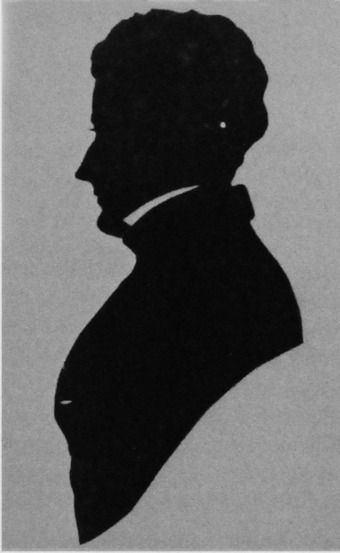
Edward James Loder
Cut silhouette
1826
4 x 3in./102 x 77mm.
Trade Label No. 2
Taken at Mr Price’s, Old Bond Street, Bath; not listed in the artist’s folios.
The sitter was known in Bath as a composer.
Victoria Art Gallery, Bath
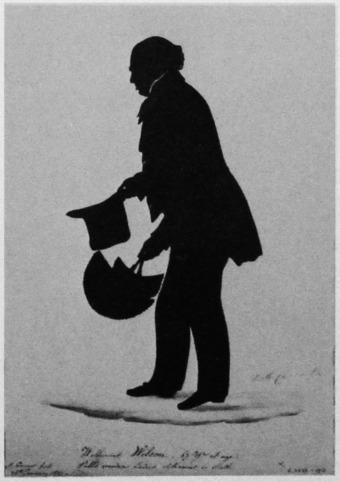
Williams Wilson
Cut silhouette
18 January 1827
Folio viii, No. 116
11 x 9½in./280 x 242mm.
In Edouart’s series, ‘Bath Characters’.
Signed ‘A. Edouart fecit, 18th January, 1827’; also inscribed ‘Williams Wilson, 67 yrs of age. Sells wooden Ladies’ Skreens in Bath.’
Crown Copyright. Victoria and Albert Museum, No. E.2426-1913
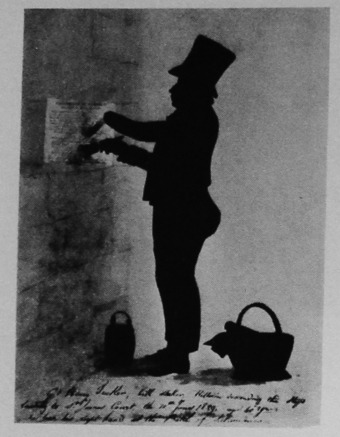
George Henry Tucker
Cut silhouette
1827
In Edouart’s series, ‘Bath Characters’ (1826-27). Tucker is represented pasting up an enlarged copy of one of Edouart’s trade labels. The silhouette bears an inscription, stating that Tucker lost his right hand at the Battle of Salamanca and that, while working as a bill-sticker, he was killed by a fall in St James’s Court, Bath, in 1829.
From E. Nevill Jackson, ‘Ancestors in Silhouette’ (1921), by courtesy of Bodley Head
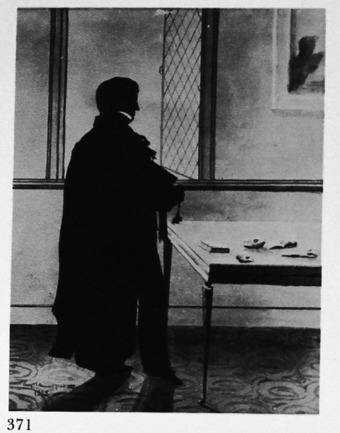
Professor Adam Sedgwick
Cut silhouette
1828
12½ x 10in./318 x 254mm.
Taken in Cambridge, for which no full folio of Eduart’s survives. Signed by the artist.
Author’s collection

The Reverend Charles Simeon
Cut silhouette
1828
11 x 9½in./280 x 242mm.
Trade Label No. 4
One of the lesser known silhouettes in the series of nine (The Rev. Charles Simeon of Cambridge Preaching, in 9 different attitudes) taken in Cambridge. Signed ‘Augn. Edouart fecit, 1828’.
Holborne of Menstrie Museum, Bath
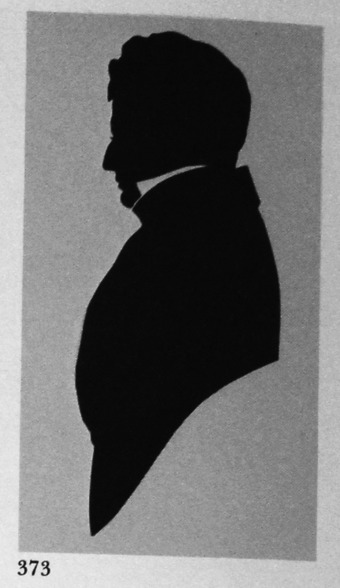
Henry Philip Hope
Cut silhouette
10 April 1829
4 x 3in./102 x 77mm.
Folio v, No. 90
One of five silhouettes which Edouart cut of Hope, of 25 Norfolk Street, Park Lane, London.
Crown Copyright. Victoria and Albert Museum, No. E.2465-1913
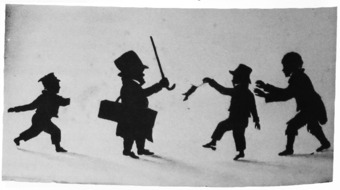
Children, apparently teasing a dwarf
Cut silhouette
1829
Signed by the artist.
Holborne of Menstrie Museum, Bath

Guest arriving at a ball
Cut silhouette
1829
Taken in Cheltenham or London; inscribed ‘Augn. Edouart fecit, 1829’.
The subject carries a chapeau bras, still fashionable for formal occasions at this date.
Holborne of Menstrie Museum, Bath
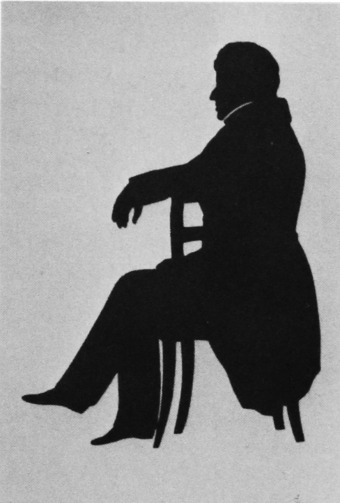
Charles X, exiled King of France
Cut silhouette
28 January 1831
Taken at Holyrood House, Edinburgh.
From E. Nevill Jackson, ‘Ancestors in Silhouette’ (1921), by courtesy of Bodley Head
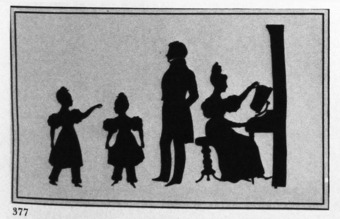
Members of the suite of Charles X, exiled King of France
Cut silhouette
26 January 1832
Folio i, No. 61
The sitters are, from left to right, Louise Bourlet, Alex. Bourlet, the Baron de St Aubin (First Valet de Chambre to the King), the Baronne de St Aubin.
From E. Nevill Jackson, ‘Ancestors in Silhouette’ (1921), by courtesy of Bodley Head

William Murray
Cut silhouette
17 August 1831
Folio i, No. 26
Murray acted as Edouart’s draughtsman’ in Scotland.
From E. Nevill Jackson, ‘Ancestors in Silhouette’ (1921), by courtesy of Bodley Head

Sir Walter Scott
Cut silhouette
1831
Taken in Edinburgh after the novelist had recovered from a serious illness. With Scott is his dog, ‘Spice’.
From E. Nevill Jackson, ‘Ancestors in Silhouette’ (1921), by courtesy of Bodley Head
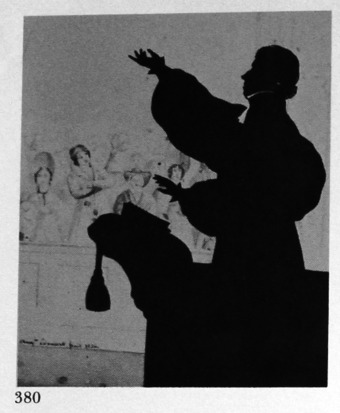
A cleric in the pulpit
cut silhouette, with painted background
1836
Trade Label No. 6
Signed. The painted background shows the faces of the congregation.
T. E. F. Sainsbury collection

Miss Jane Collins, of Westgate, Norwich
Cut silhouette
26 July 1837
Folio v, No. 81
Taken in Leamington.
Crown Copyright. Victoria and Albert Museum, No. E.2464-1913

Mrs John Stokes, of Caldecot, Rutland
Cut silhouette
13 September 1837
Folio v, No. 155
Taken in Leamington.
Crown Copyright. Victoria and Albert Museum, No. E.2468-1913
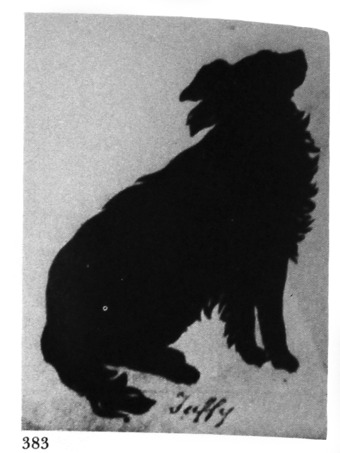
Taffy, the Brockman family’s dog
Detail from a cut group silhouette of Captain Brockman’s children
1837
The silhouette (250) of which this is a detail was taken in Leamington.
Author’s collection

Family group
Cut silhouette
April 1839
16¾ x 22 7/8 in./426 x 582mm.
Taken on a stop in Belfast while Edouart was on his way to the United States. Signed ‘Aug. Edouart fecit, 1839, April’. Below the figure of the child with the truck is written, ‘3 feet 4½ inches. Born 24th June, 1834’; below that of the child with the doll, ‘2 feet 10½ inches, Born 25th May 1836’; below that of the baby, ‘Born 20th April, 1838’.
Ulster Museum, Belfast
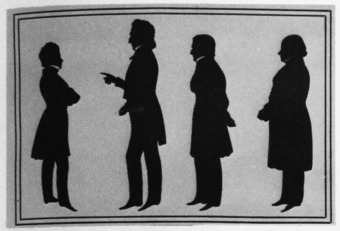
Four presidents of the United States
Cut silhouette
The sitters are, from left to right; Franklin Pierce, John Tyler, William Henry Harrison, John Quincey Adams.
From E. Nevill Jackson, ‘Ancestors in Silhouette’ (1921), by courtesy of Bodley Head
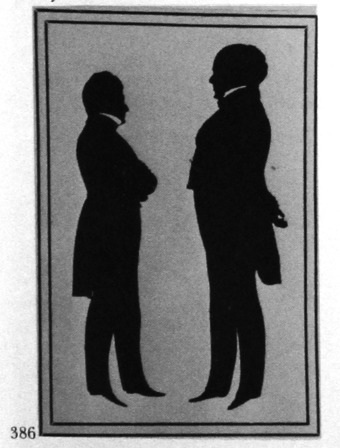
Two presidents of the United States
Cut silhouette
The sitters are Millard Fillmore (left) and Martin Van Buren.
From E. Nevill Jackson, ‘Ancestors in Silhouette’ (1921), by courtesy of Bodley Head

Two eminent Americans
Cut silhouette
The sitters are W. L. Marcy (left) and William Henry Seward.
From E. Nevill Jackson, ‘Ancestors in Silhouette’ (1921), by courtesy of Bodley Head

Two eminent Americans
Cut silhouette
The sitters are Daniel Webster (left) and Henry Clay.
From E. Nevill Jackson, ‘Ancestors in Silhouette’ (1921), by courtesy of Bodley Head
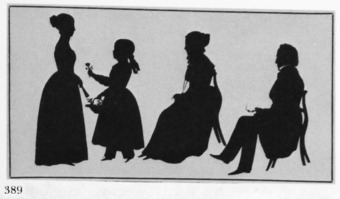
A group of American citizens
Cut silhouette
1842
The sitters are, from left to right, Miss Mary Sophia Quincey, Miss Annie Lloyd Green, Mrs Josiah Quincey, Josiah Quincey.
From E. Nevill Jackson, ‘Ancestors in Silhouette’ (1921), by courtesy of Bodley Head
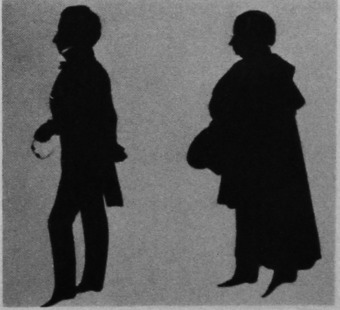
Two eminent Americans
Cut silhouette
The sitters are Robert C. Winthrop (left) and Timothy Bigelow.
From E. Nevill Jackson, ‘Ancestors in Silhouette’ (1921), by courtesy of Bodley Head
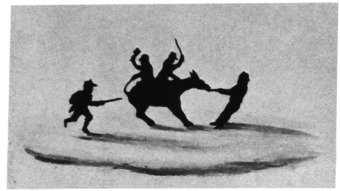
A typical example of genre cutting by Augustin Edouart.
Size 3 x 4in./77 x 102mm.
Trade Label No. 5.
Author’s collection

Lithographed interior background by Unkles and Klason, of Cork.
Backgrounds of this type, both interior and exterior, were found among Augustin Edouart’s effects after his death.
From E. Nevill Jackson, ‘Ancestors in Silhouette’ (1921), by courtesy of Bodley Head
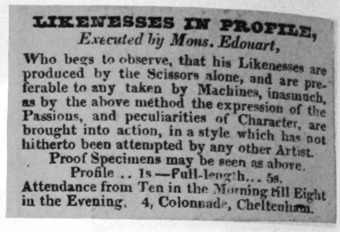
Trade Label No. 1 of Augustin Edouart. Note the lowe prices: 1s for bust-length silhouettes, 5s for full-length.
Author’s collection
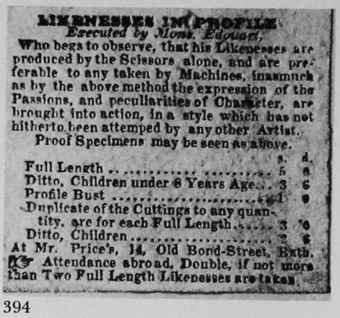
Trade Label No. 2 of Augustin Edouart.
Victoria Art Gallery, Bath
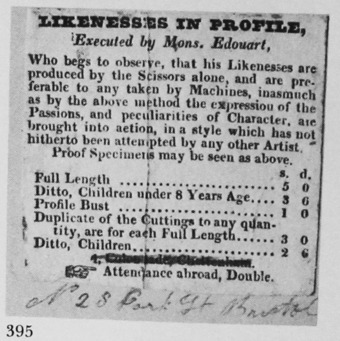
Trade Label No. 3 of Augustin Edouart. Edouart’s earlier address (4 Colonnade, Cheltenham) has been deleted.
Author’s collection
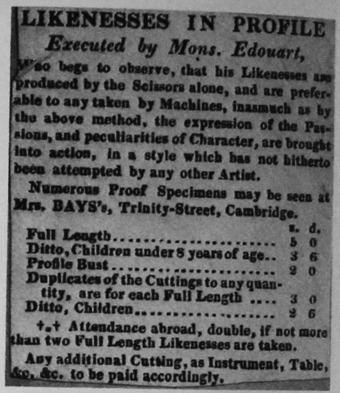
Trade Label No. 4 of Augustin Edouart.
Holborne od Menstrie Museum, Bath
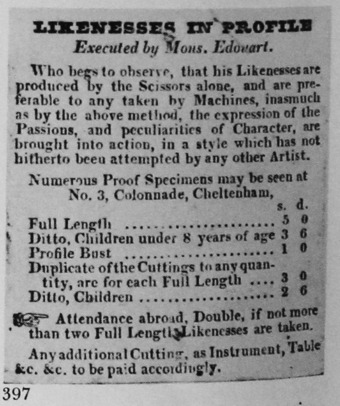
Trade Label No. 5 of Augustin Edouart.
Author’s collection

Trade Label No. 6 of Augustin Edouart.
T. E. F. Sainsbury collection
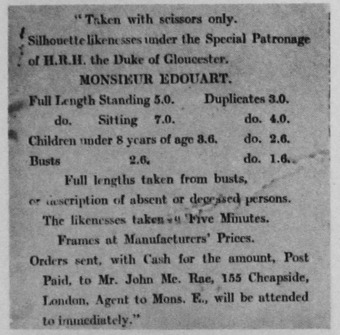
Trade Label No. 7 of Augustin Edouart. Coke owned a silhouette, dated 1837, bearing this label.
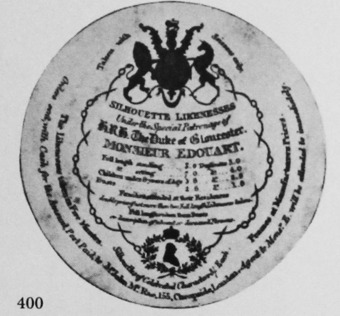
Trade Label No. 8 of Augustin Edouart. More elaborate than the artist’s other trade labels, this shows a bust-length silhouette of the Duke of Gloucester and the Duke’s coat of arms.
From E. Nevill Jackson, ‘Silhouette: Notes and Dictionary’ (1938), by courtesy of Methuen and Co. Ltd

The reverses of two silhouettes, full-length (left) and bust-length, showing how Augustin Edouart named and dated his works. The silhouettes are of Thomas MacMicking, junior, of Liverpool (left; Glasgow, 21 February 1832), and of the Reverend John Campbell, who died on 20 July 1828 (posthumous, taken from a bust; Glasgow, 6 January 1832; Folio ii, No. 313).
From E. Nevill Jackson, ‘Ancestors in Silhouette’ (1921), by courtesy of Bodley Head

Handwritten signature of Augustin Edouart, from one of his silhouettes.
T. E. F. Sainsbury collection

Stencilled signature of Augustine Edouart, from one of his silhouettes.
Holborne of Menstrie Museum, Bath
DETAIL

Detail from a silhouette of a man by Augustin Edouart, showing the sitter’s trousers and shoes (tied with strings, indicated by careful cutting).
